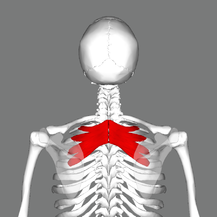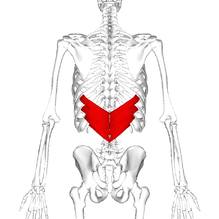Serratus Posterior: Difference between revisions
Kim Jackson (talk | contribs) No edit summary |
Kim Jackson (talk | contribs) No edit summary |
||
| Line 5: | Line 5: | ||
</div> | </div> | ||
== Description == | == Description == | ||
We have two serratus muscles the most | We have two serratus muscles: the most commonly known [[Serratus Anterior|serratus anterior muscle]] and the less common serratus posterior muscle. | ||
The serratus posterior muscle is an intermediate layer of back muscles, consisting of the serratus posterior superior and serratus posterior inferior. | |||
=== Origin === | === Origin === | ||
[[File:Serratus posterior superior muscle back.png|thumb|217x217px|serratus posterior superior]] | [[File:Serratus posterior superior muscle back.png|thumb|217x217px|serratus posterior superior]] | ||
Serratus | * '''Serratus Posterior Superior''': Originates from the C7-T3 vertebrae spinous process and nuchal ligament. | ||
* '''Serratus Posterior Inferior''': Originates from the T11-L2 vertebrae spinous process | |||
[[File:Serratus posterior inferior muscle back2.png|thumb|219x219px|serratus posterior inferior]] | [[File:Serratus posterior inferior muscle back2.png|thumb|219x219px|serratus posterior inferior]] | ||
=== Insertion === | === Insertion === | ||
Serratus | * '''Serratus Posterior Superior''': Inserts at the upper border of the 2nd-5th ribs. | ||
* '''Serratus Posterior Inferior''': Inserts at the lower border of the 9th-12th ribs. | |||
Serratus | |||
=== Nerve === | === Nerve === | ||
* The serratus posterior superior is innervated by the ventral rami of the intercostal nerves of T1-T5. | |||
* The serratus posterior inferior is innervated by the ventral rami of the intercostal nerves of T9-T12. | |||
== Function == | == Function == | ||
Both serratus posterior superior and inferior are accessory [[Muscles of Respiration|muscles for respiration,]] | Both serratus posterior superior and inferior are accessory [[Muscles of Respiration|muscles for respiration,]] balthough there is no electromyographic evidence to support their respiratory roles.<ref>Loukas M, Louis RG, Wartmann CT, Tubbs RS, Gupta AA, Apaydin N, Jordan R. [https://link.springer.com/article/10.1007%2Fs00276-008-0305-x An anatomic investigation of the serratus posterior superior and serratus posterior inferior muscles]. Surgical and Radiologic Anatomy. 2008 Mar 1;30(2):119-23.</ref>. | ||
Serratus | * '''Serratus Posterior Superior''': Elevates the ribs during inspiration (acts as an accessory muscle of inspiration) and has a stabilisation role for the thorax. | ||
* '''Serratus Posterior Inferior''': Depresses the ribs during expiration (acts as an accessory muscle of expiration). | |||
Bilateral action of posterior superior/posterior inferior | Bilateral action of the posterior superior/posterior inferior reduces extension of thoracic vertebrae. | ||
Unilateral action | Unilateral action rotates the spine to opposite side. | ||
== Clinical relevance == | == Clinical relevance == | ||
Both the serratus posterior superior and serratus posterior inferior, especially serratus posterior superior, may participate in and cause [[Myofascial Pain|myofascial pain syndrome]]. It's referred pain pattern can be overlapped with other muscles as it lies deeper. | |||
This referred pain starts from back of shoulder runs to elbow and ulnar side of wrist | This referred pain starts from the back of the shoulder, runs to elbow, and ulnar side of wrist.<ref>Vilensky JA, Baltes M, Weikel L, Fortin JD, Fourie LJ. [https://onlinelibrary.wiley.com/doi/epdf/10.1002/ca.1039 Serratus posterior muscles: anatomy, clinical relevance, and function. Clinical Anatomy:] The Official Journal of the American Association of Clinical Anatomists and the British Association of Clinical Anatomists. 2001 Jul;14(4):237-41.</ref> It may refer also to the chest and inner arm. | ||
Serratus posterior inferior pain is localized and | Serratus posterior inferior pain is localized and does not have a referred pattern. | ||
Another contribution to serratus posterior superior muscle is due to improper posture or inappropriate use of muscle for example holding phone between ear and shoulder | Another contribution to serratus posterior superior muscle pain is due to improper posture or inappropriate use of muscle for example holding a phone between ear and shoulder, which can cause scapulocostal syndrome and may be misdiagnosed with a lesion of spinal nerves of the cervical spine.<ref>Fourie LJ. [https://www.ncbi.nlm.nih.gov/pubmed/2047965 The scapulocostal syndrome]. South African Medical Journal. 1991;79(6):721-4.</ref> | ||
== Treatment == | == Treatment == | ||
The muscle cannot be palpated as it lies under the trapezius, rhomboids, back muscles and other back muscles. To better expose the serratus posterior superior muscle, it is necessary to manoeuvre the shoulder blade. | |||
{{#ev:youtube|HTbSxooHIRc|300}}<ref>Richard Finn. Serratus Posterior Superior Richard Finn LMT, CMTPT, MCSTT. Available from: http://www.youtube.com/watch?v=HTbSxooHIRc[last accessed 12/3/2020]</ref> | {{#ev:youtube|HTbSxooHIRc|300}}<ref>Richard Finn. Serratus Posterior Superior Richard Finn LMT, CMTPT, MCSTT. Available from: http://www.youtube.com/watch?v=HTbSxooHIRc[last accessed 12/3/2020]</ref> | ||
Patient can apply self message for | Patient can apply self message for serratus posterior superior muscle using '''message bal'''l or '''trigger fairy.''' | ||
''' | '''Message bal'''l | ||
* Place the ball beside your shoulder blade at the level of spine of scapula. | |||
* Then move your arm to the other side that will move your shoulder blade away and allow more exposure of muscle. | |||
* Once you find a trigger point stop and apply slow precise movement. | |||
'''Trigger fairy''' | |||
For better results take slow deep breathing and elongate the exhalation while you stat on trigger point with fairy. | * This is easier and less exhausting than message pall. | ||
* First, cross your arm to apposite side and use the contralateral hand to hold the trigger fairy place it on the muscle and search for trigger points, | |||
* When you find one stop and use the message fairy to apply circular movement or pull the fairy forward and downward. | |||
* For better results take slow deep breathing and elongate the exhalation while you stat on trigger point with fairy. | |||
== References == | == References == | ||
Revision as of 13:45, 9 April 2024
Original Editor - Khloud Shreif
Top Contributors - Khloud Shreif, Kim Jackson and Ahmed M Diab
Description[edit | edit source]
We have two serratus muscles: the most commonly known serratus anterior muscle and the less common serratus posterior muscle.
The serratus posterior muscle is an intermediate layer of back muscles, consisting of the serratus posterior superior and serratus posterior inferior.
Origin[edit | edit source]
- Serratus Posterior Superior: Originates from the C7-T3 vertebrae spinous process and nuchal ligament.
- Serratus Posterior Inferior: Originates from the T11-L2 vertebrae spinous process
Insertion[edit | edit source]
- Serratus Posterior Superior: Inserts at the upper border of the 2nd-5th ribs.
- Serratus Posterior Inferior: Inserts at the lower border of the 9th-12th ribs.
Nerve[edit | edit source]
- The serratus posterior superior is innervated by the ventral rami of the intercostal nerves of T1-T5.
- The serratus posterior inferior is innervated by the ventral rami of the intercostal nerves of T9-T12.
Function[edit | edit source]
Both serratus posterior superior and inferior are accessory muscles for respiration, balthough there is no electromyographic evidence to support their respiratory roles.[1].
- Serratus Posterior Superior: Elevates the ribs during inspiration (acts as an accessory muscle of inspiration) and has a stabilisation role for the thorax.
- Serratus Posterior Inferior: Depresses the ribs during expiration (acts as an accessory muscle of expiration).
Bilateral action of the posterior superior/posterior inferior reduces extension of thoracic vertebrae.
Unilateral action rotates the spine to opposite side.
Clinical relevance[edit | edit source]
Both the serratus posterior superior and serratus posterior inferior, especially serratus posterior superior, may participate in and cause myofascial pain syndrome. It's referred pain pattern can be overlapped with other muscles as it lies deeper.
This referred pain starts from the back of the shoulder, runs to elbow, and ulnar side of wrist.[2] It may refer also to the chest and inner arm.
Serratus posterior inferior pain is localized and does not have a referred pattern.
Another contribution to serratus posterior superior muscle pain is due to improper posture or inappropriate use of muscle for example holding a phone between ear and shoulder, which can cause scapulocostal syndrome and may be misdiagnosed with a lesion of spinal nerves of the cervical spine.[3]
Treatment[edit | edit source]
The muscle cannot be palpated as it lies under the trapezius, rhomboids, back muscles and other back muscles. To better expose the serratus posterior superior muscle, it is necessary to manoeuvre the shoulder blade.
Patient can apply self message for serratus posterior superior muscle using message ball or trigger fairy.
Message ball
- Place the ball beside your shoulder blade at the level of spine of scapula.
- Then move your arm to the other side that will move your shoulder blade away and allow more exposure of muscle.
- Once you find a trigger point stop and apply slow precise movement.
Trigger fairy
- This is easier and less exhausting than message pall.
- First, cross your arm to apposite side and use the contralateral hand to hold the trigger fairy place it on the muscle and search for trigger points,
- When you find one stop and use the message fairy to apply circular movement or pull the fairy forward and downward.
- For better results take slow deep breathing and elongate the exhalation while you stat on trigger point with fairy.
References[edit | edit source]
- ↑ Loukas M, Louis RG, Wartmann CT, Tubbs RS, Gupta AA, Apaydin N, Jordan R. An anatomic investigation of the serratus posterior superior and serratus posterior inferior muscles. Surgical and Radiologic Anatomy. 2008 Mar 1;30(2):119-23.
- ↑ Vilensky JA, Baltes M, Weikel L, Fortin JD, Fourie LJ. Serratus posterior muscles: anatomy, clinical relevance, and function. Clinical Anatomy: The Official Journal of the American Association of Clinical Anatomists and the British Association of Clinical Anatomists. 2001 Jul;14(4):237-41.
- ↑ Fourie LJ. The scapulocostal syndrome. South African Medical Journal. 1991;79(6):721-4.
- ↑ Richard Finn. Serratus Posterior Superior Richard Finn LMT, CMTPT, MCSTT. Available from: http://www.youtube.com/watch?v=HTbSxooHIRc[last accessed 12/3/2020]








